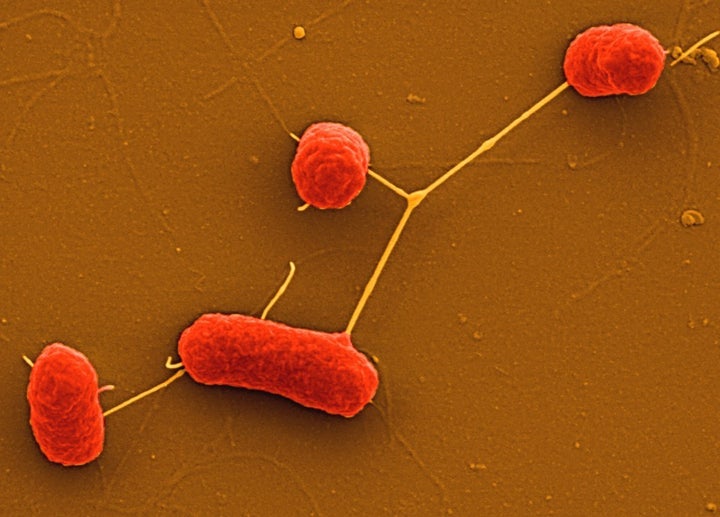
An electron microscope image of E. coli bacteria
By Sarah Zhang
The alarm bells sounded on November 18, 2015.
Antibiotic resistance is usually a slow-moving crisis, one of the reasons its danger can be hard to convey. One by one, over the years, the drugs used to fight the most stubborn infections have fallen by the wayside as bacteria have evolved resistance to them. For certain infections, the only drug left is colistin. Then on November 18, 2015, scientists published a report in the British medical journal The Lancet: A single, easily spreadable gene makes the bacteria that carry it resistant to colistin, our antibiotic of last resort.
Chinese scientists had found this gene, called mcr-1, in pig farms and on meat in supermarkets. Why pigs? Herein lies in the irony. Colistin is an old drug and, by modern standards, not a great one. It can cause severe kidney damage. As scientists developed better antibiotics over the decades, colistin fell out of human use. So in China, farmers started using it by the tons in animals, where low doses of antibiotics can promote growth.
Now it’s come full circle. Bacteria have evolved resistance to so many of those “better” antibiotics that colistin is critical for human health again. China didn’t use colistin in humans, but many countries including the U.S. do as a last resort.
Even more worrisome in the Lancet report was evidence that mcr-1 had already leapt from pigs to humans. Out of 1322 patient samples from hospitals in China, the team found 16 containing mcr-1. And, of course, drug-resistant bacteria don’t respect national borders. As the team was writing up its report, it noticed other researchers had uploaded genomes of bacteria in Malaysia containing the mcr-1 gene sequence to an online database. “The possibility that mcr-1-positiveE. coli have spread outside China and into other countries in southeastern Asia is deeply concerning,” the authors warned.
To be clear, these E. coli with mcr-1 found in China were still susceptible to antibiotics other than colistin, but if a bacterium with genes that make it resistant to every other drug then picks up mcr-1, you get the nightmare scenario: a pan-resistant bacteria. These drug- resistant infections usually happen in people who are already sick or have weakened immune systems.
The Lancet report immediately kicked off a flurry of activity in microbiology labs around the world. And soon enough, the reports started coming out. In December, scientists reported finding mcr-1 in Denmark. Then Germany and Vietnam and Spain and United States and on and on. It seems like every month is a new mcr-1 development, I said to James Spencer, a microbiologist University of Bristol who collaborated with the Chinese scientists on the original Lancetpaper. “Every week,” he corrected me. By the time anyone had figured out mcr-1’s existence, it had already spread around the world.
The story of mcr-1’s silent spread is, by now, a familiar one. Over and over, scientists have identified genes conferring resistance to a class of antibiotics, only to find the gene had circled the globe. Another recent example is ndm-1, a gene found in 2009 that confers resistance to class of antibiotics called carbapenems. “It’s very rare to catch something at the very beginning,” says Alexander Kallen, a medical epidemiologist with the Centers for Disease Control and Prevention. Looking for resistance is a constant game of catch-up. You don’t notice anything until there is something to notice; by the time there is something to notice, something bad has already happened. And you have to have eyes everywhere: Resistance initially found on a Chinese pig farm could repercussions all over the world.
When Timothy Walsh, a microbiologist at Cardiff University first heard of mcr-1’s existence from his colleague Yang Wang of China Agricultural University, he didn’t believe it. “It’s like the holy grail of resistance,” says Walsh. He was also skeptical because of the way colistin works. The antibiotic binds to molecules on the surface of bacteria—and modifying those molecules typically requires mutations in several different genes. Instead of getting lucky just once, that bacteria would have to get lucky several times to beat off colistin. In fact, other researchers had identified colistin-resistant bacteria before, which had multiple mutations in the DNA in their chromosomes.
But mcr-1 was just one gene. And more importantly, it didn’t live on chromosomes, which are tightly wound pieces of DNA. The mcr-1 gene sits on a little loop of free-floating DNA called a plasmid, which bacteria—even bacteria of different species—can easily swap like bracelets. That makes mcr-1 much easier to spread. A single bacteria might collect multiple plasmids with multiple genes for resistance to multiple antibiotics. Scientist have not yet found bacteria with mcr-1 that is resistant to all antibiotics, but don’t make the mistake of optimism. “It’s not a case of ‘if.’ It’s a case of ‘when,’” says Walsh.
Meanwhile, the detailed work of understanding mcr-1 is inching along. In just over a year, scientists have published nearly 150 papers on mcr-1. Spencer and Walsh — along with three other groups based in the U.S. and China — have each published recent papers looking at the protein that mcr-1 makes. It appears to be a protein sticks out of the bacteria’s surface, and it has the ability to modify other surface molecules. It seems to need zinc to properly function. But a lot is still unknown.
Walsh is now also collaborating on studies in China, Vietnam, and Thailand looking to see how widespread mcr-1 is among bacteria in the environment — outside of the just pig farms, supermarkets, and hospitals. They’re looking at bacterial samples from migratory birds and dogs and the gut microbiota of healthy humans. Whenever animals or people migrate, bacteria migrate. “What actually may occur in the U.S., U.K., Africa, or China, invariably becomes all our problems,” says Walsh.
This story originally appeared on TheAtlantic.com.
More from The Atlantic: The Life-Changing Magic of Mushrooms, The Different Stakes of Male and Female Birth Control